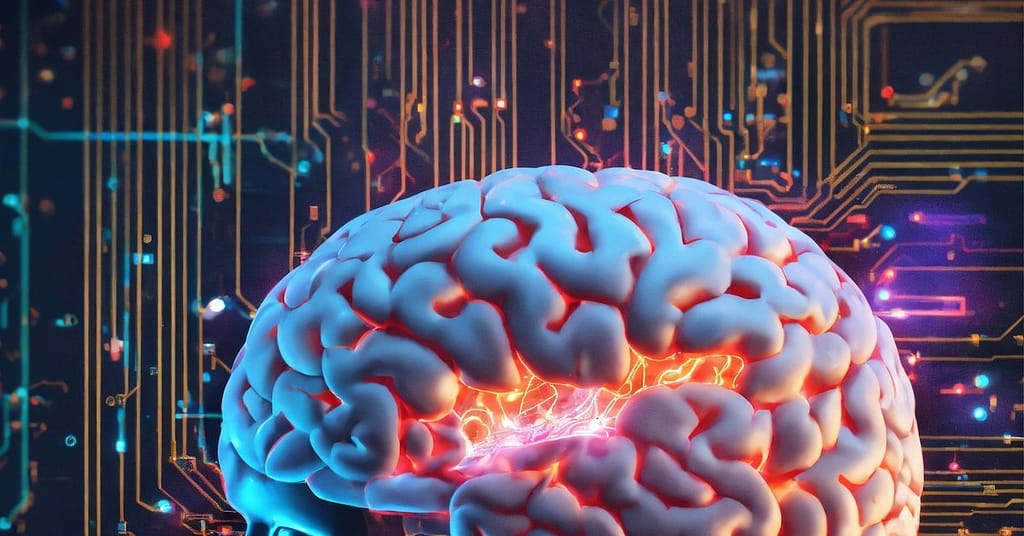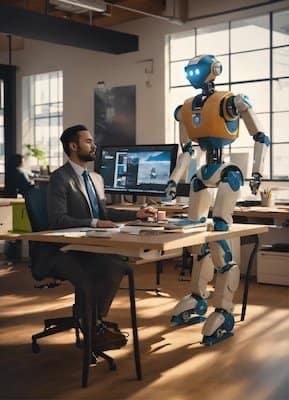Hey there, curious minds! Ever wonder what the future looks like? I’m not talking flying cars or living on Mars. I mean stuff—like how AGI will change the future of work. If you’re scratching your head at “AGI,” let me break it down for you. AGI stands for Artificial General Intelligence. It’s like the big sibling of regular AI. Imagine a world where machines can do any intellectual task that humans can do. Scary? Exciting? Either way, it’s coming, and it’s high time we talk about it.
When realized, AGI has the potential to excel in any cognitive function that humans or animals are capable of. Another definition frames AGI as an autonomous entity that exceeds human performance in the majority of economically valuable tasks. Companies like OpenAI, DeepMind, and Anthropic are laser-focused on developing AGI as their ultimate goal. Additionally, AGI frequently makes an appearance in the realms of science fiction and futures studies.

The Road to AGI: Milestones and Breakthroughs
What Exactly Is AGI?
We’re all somewhat familiar with AI—computers that can do specific tasks really well, like Google’s search algorithm or Netflix’s recommendation system. But AGI, or Artificial General Intelligence, is a whole other animal. OpenAI co-founder Greg Brockman predicts humanity might just hit this AGI milestone by 2030.
General Intelligent Action
This is a cornerstone concept in the AGI (Artificial General Intelligence) discussion. Unlike specialized AI, which is trained for a specific task like language translation or playing chess, AGI with General Intelligent Action has the adaptability to perform any intellectual task that a human can do.
Imagine an AI system that could write a symphony, diagnose an illness, write a novel, and develop a new scientific theory. In other words, it’s like having an Einstein, Beethoven, and Hemingway all rolled into one super-smart machine. This is how AGI will change the future of work.
This flexibility and adaptability are what make the concept of General Intelligent Action so darn exciting (and challenging to achieve).
Superintelligence
So, you’ve got smart, and then you’ve got super smart—that’s what we’re talking about here. Superintelligence refers to an AGI system whose intellectual abilities are significantly beyond human reach.
We’re talking about a level of problem-solving, creative thinking, and emotional understanding that leaves even the smartest humans in the dust. With superintelligence, the AI could potentially solve complex issues like climate change or develop medical treatments in the blink of an eye.
But, it’s not all rosy; this level of intelligence could also pose considerable risks if not properly managed. Like, think Skynet from “Terminator” but hopefully with less “end-of-the-world” vibes.
Strong AI
This term is often used interchangeably with AGI, but when people talk about Strong AI, they’re emphasizing the full range of human cognitive abilities. It’s not just about mimicking human behavior but truly understanding and replicating human thought processes.
Strong AI would have self-awareness, emotional understanding, and the ability to handle highly complex tasks involving deep reasoning and problem-solving. It’s not just a chatbot that can book you a hotel room; it’s more like Data from “Star Trek,” capable of nuanced thought and emotional understanding.
The Challenges on the AGI Timeline
AGI is not a walk in the park. One big roadblock? We still don’t know everything about how the human brain works. Also, existing AI systems come with their own set of biases, leading to some pretty sketchy, unfair outcomes. And it leads us to keep questioning how AGI will change the future..
AGI Challenges
- Understanding the Human Brain: One of the biggest hurdles in developing AGI is our limited understanding of how the human brain works. It’s like trying to build a high-performance car without fully understanding the mechanics of an internal combustion engine. Our brains are complex structures, and replicating that in a machine is no small feat.
- Ethical Considerations: The implications of creating something that might out-think us are enormous. Should AGI have rights? How do we ensure it aligns with human values? Lots to chew on here.
- Data Biases: AI and AGI learn from data, and if that data is biased (like, say, historical employment records that favor men over women), then the machine will be biased too. Cleaning up data and ensuring it’s as neutral as possible is a massive challenge in AGI development.
AGI Risks
- Job Displacement: Let’s face it, when machines can do everything we can do but better, what’s left for us? The threat to job markets is real and something that needs proactive planning, like potential re-skilling programs or even discussions around universal basic income.
- Development of Autonomous Weapons: Imagine an AI that can make decisions in a battlefield scenario. Scary, right? There are significant risks in developing AGI that can be weaponized. Just because we can do it doesn’t necessarily mean we should.
AGI Ethics
The golden thread tying all these challenges and risks together is ethics. The ethical development of AGI isn’t just a nice-to-have; it’s a must-have. We need strict guidelines to ensure that AGI is developed in a way that aligns with human values and benefits society as a whole.
There are a whole lot of questions to answer: who gets to control AGI? How transparent should its decision-making process be? What safeguards are in place if things go awry? It’s a Pandora’s box of ethical quandaries that researchers, policymakers, and ethicists need to open carefully.
AGI’s Impact: Benefits, Risks, and Ethics
The Upside: AGI Benefits and Advancements
If Brockman’s right, AGI could transform society in unimaginable ways. From game-changing advancements in healthcare to potential solutions to the climate crisis, the sky’s the limit.
But What About the Risks?
The whole AGI thing isn’t all sunshine and roses. It’s got a darker side, a slew of ethical and practical challenges that we can’t just swipe under the rug. We’re talking Skynet-level stuff if we’re not careful.
AGI and Human Collaboration
This is the million-dollar question: If AGI can do everything we can, where do we fit in? Imagine going to work and your co-worker isn’t Joe from accounting but an AGI system that can analyze financial data in seconds. How do you even “collaborate” with something like that?
On one hand, AGI could handle the boring, repetitive tasks, leaving us to be more creative. On the other hand, could we end up becoming obsolete, or worse, dependent on AGI for our very survival?
AGI and Automation
It’s simple math, right? The more jobs machines can do, the fewer jobs there are for us meatbags. We’re already seeing automation creeping into sectors like manufacturing, customer service, and even creative jobs. If AGI comes into the picture, that scope expands to pretty much… well, everything. So yeah, that’s a huge “uh-oh” moment for the job market.
AGI’s Ethical Maze
Dude, you can’t chitchat about AGI without diving deep into the ethical swamp. It’s like giving a teenager the keys to a sports car and saying, “Have fun, don’t crash!” The people building AGI have got to remember that with this kind of power comes a boatload of responsibility.
They’ve gotta ensure that AGI isn’t just smart but also ethical, respectful of human values, and not a total existential threat to humanity.
AGI and the Future of Work: A Post-Scarcity Society?
If AGI does become a reality, the way we work could transform completely. Imagine a future where menial jobs are automated, freeing up humans to engage in more meaningful, creative endeavors. The development of new technologies and possibly even a post-scarcity society could be within reach. That’s why it’s so important for humanity to find out as soon as possible how AGI will change the future.
Final Thoughts on How Will AGI Change the Future of Work
So, how will AGI change the future of work? It’s a loaded question with no easy answers. But one thing is for sure: AGI is coming, and it’s going to make waves. The key is to ride them, not get swept away.
Meet the Visionary: Greg Brockman

If you’re diving into the world of AGI, you can’t do it without mentioning Greg Brockman, the co-founder and president of OpenAI. This guy is a bona fide rock star in the realm of artificial general intelligence (AGI) research.
Early Career & Stripe Era
Brockman wasn’t always an AGI maven. He got his start as a software engineer at Google, tinkering with natural language processing and machine learning tech. But in 2010, he decided to step it up a notch by co-founding Stripe, a financial juggernaut now valued at a jaw-dropping $95 billion.
The OpenAI Journey
In 2015, he left Stripe and teamed up with Elon Musk and Sam Altman to launch OpenAI. Their mission? To make AGI safe and beneficial for everyone, not just the tech elites. Brockman’s all about that AGI ethics life, striving to ensure the technology impacts society in a positive way.
More Than Just OpenAI
Besides running OpenAI, Brockman wears quite a few other hats. He’s on the board of the Artificial Intelligence Research Institute and the Center for Emerging Risk Research. Both organizations are all about sussing out the risks and rewards of emerging tech.
He’s also a co-founder of the Partnership on AI, another non-profit that aims to direct AI towards the greater good.
Why Brockman Matters in AGI Development
Brockman’s not just some tech bro in a hoodie; he’s a leading voice, pushing for AGI to be developed responsibly. He’s got papers, talks, and a seat at the table of pretty much every important AI discussion.
Simply put, Greg Brockman is a beacon in the complex landscape of AGI development and policy. His advocacy for responsible AI development sets the bar high, emphasizing that with the power of AGI, comes a heap of responsibility.
RELATED POSTS
The Top 10 Trending Topics on Search Engines in 2023
Blockchain AI Applications: The Future of Technology




